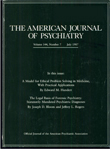Divergences between clinical and research methods for assessing personality disorders: implications for research and the evolution of axis II
Abstract
OBJECTIVE: The purpose of this study was to examine the extent to which instruments for assessing axis II diverge from clinical diagnostic processes. METHOD: Subjects in the first study were 52 clinicians with experience in assessment and treatment of patients with personality disorders, who were surveyed about the methods they use in clinical practice to make diagnoses and other aspects of the diagnostic process. A second study replicated the major findings with a random national sample of 1,901 experienced psychiatrists and psychologists. RESULTS: Whereas current instruments rely primarily on direct questions derived from DSM-IV, clinicians of every theoretical persuasion found direct questions useful for assessing axis I disorders but only marginally so for axis II. They made axis II diagnoses, instead, by listening to patients describe interpersonal interactions and observing their behavior with the interviewer. In contrast to findings with current research instruments, most patients with personality disorders in clinical practice receive only one axis II diagnosis, and if they receive more than one, one is considered primary. Clinicians reported treating a substantial number of patients for enduring personality patterns that current axis II instruments do not assess, many of which meet neither axis I nor axis II criteria, notably problems with relatedness, work, self-esteem, and chronic subclinical depressive traits. CONCLUSIONS: Measurements of axis II were constructed by using a model derived from axis I instruments that diverges from clinical diagnostic procedures in a way that may be problematic for the assessment of personality disorders and the development of a more clinically and empirically sound taxonomy.



